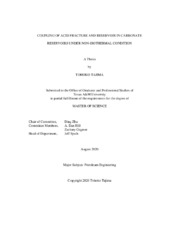| dc.description.abstract | Modeling acid fracturing process is challenging because of the coupled complex effects of flow through porous medium and fracture, chemical reaction in a geostatistic base, wormhole propagation and reservoir heterogeneity. To avoid the complexity, decoupled approaches are commonly used, and often the reservoir effect is represented by leakoff effect with a constant leakoff coefficient. An acid fracturing numerical model is presented that is coupled with a single-phase black oil reservoir simulator for a vertical well in carbonate reservoir. To analyze the benefits of coupled modeling, a comparison is performed with a conventional acid fracturing model that is decoupled from reservoir model.
The coupled acid fracturing model considers fracture propagation and closure, acid transport, and heat transfer. After simulate acid fracturing, conductivity of the fracture is calculated using empirical correlations, and the productivity is computed by simulating the flow to the well. Non-isothermal condition is assumed to simulate the flow in both fracture and reservoir because the acid reaction temperature sensitive. Leakoff from fracture to reservoir is simulated with a reservoir flow model for pressure and leakoff velocity as functions of time and location. Wormhole propagation from the fracture is considered by using empirical equations for wormhole propagation based on leakoff velocity estimated from the reservoir simulation. Governing equations and computation procedure used to develop the model are illustrated in the paper with details.
Comparisons of the coupled and decoupled acid fracturing models are performed. The results show that the coupling reservoir model improves the estimated in fracture conductivity. A case study is presented to illustrate the significance of coupling process in simulation of acid fracturing. The effect of wormholing on acid fracture conductivity is also investigated. Wormhole propagation causes high leakoff at the entrance of the fracture and results in higher conductivity at the fracture entrance. The wormhole propagation has little effect on fracture geometry and acid penetration distance. It is concluded based on the observation of the study that the leakoff from acid fracture represented by reservoir model with wormhole propagation is important to correctly understand acid fracture efficiency. Simply using a constant leakoff coefficient can lead to significant error and misleading conclusions. | en |


